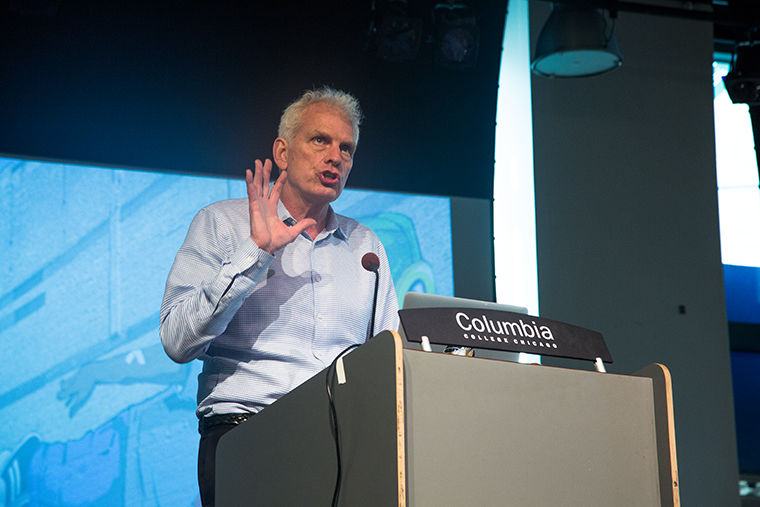‘Big Walls’ artists talk street art
Mark Kelly, vice president of Student Success, introduced the “Big Walls” panel May 5.
May 9, 2016
Six white stools, microphones and a large gong set the scene for the first ever “street style” panel discussion held by the Wabash Arts Corridor committee May 5 at the Conaway Center in the 1104 S. Wabash Ave. Building.
The artist panel discussion and reception, “WAC: Big Walls in A Big City,” kicked off the first WAC Big Walls Festival, which runs May 1–13.
The panel discussion, presented in a fast-paced style with a gong to time answers, featured local and international artists and one professor, some of whom contributed to “Big Walls.”
The artists on the panel were Ruben Aguirre, a 2002 art + design alumnus; Dutch artist Collin van der Sluijs; Marina Zumi from Argentina; Chicago painter Amanda Williams; second-year graduate student and WAC intern Anisa Peraica; and Sabina Ott, a conceptual artist and professor in the Art & Art History Department.
The discussion was moderated by Duncan Mackenzie, assistant professor in the Art & Art History Department, who also works for the “Bad at Sports” podcast, and Neysa Page-Lieberman, director of Exhibitions, Performance and Student Spaces. It focused on the ever-growing presence of street art and the public’s evolving perception of the art.
“We are beginning to transform the perception of street art in the city,” said Mark Kelly, vice president of Student Success, who introduced the panel. “[It’s] no longer for outlaws and pioneers, but it starts to untether our imagination about how street and public art might reshape our landscape around us.”
The panelists discussed the importance of street art and public art in an educational environment like Columbia’s campus.
“The WAC is good for Chicago in terms of the global ecosystem. We are behind [compared to other cities], and so this is a milestone,” said Aguirre, who is painting his mural on the south-facing side of the Goodman Center, located at 501 S. Wabash Ave.
Among the accomplishments mentioned of the WAC, Aguirre only had one complaint—the illegality of purchasing spray paint in Chicago.
“There are a lot of supporters already to legalize it, but [because of] a simple thing like that, everybody here had to get their paint driven [from elsewhere],” he said.
The WAC’s impact greatly benefits the student community, said Peraica, a second-year business & entrepreneurship graduate student who helped develop the “Big Walls” project.
“It has given me a skillset that is hugely valuable to what I want to do in the future,” she said. “Now I can go out and market [myself] in a professional way.”
Ashley King, a freshman design major who acted as the official gong-hitter to time the artists’ answers, said the panel made her think differently about street art.
“The way the artists brought attention to appropriation was amazing,” King said. “Being a millennial, [I thought] it was cool that their views connect to our views because there is such a gap between the two ages—the adult art world and the growing art world.”
The panel discussed artwork “over saturation,” one result of social media, but also acknowledged its positive influences.
Zumi, who is painting her mural on the 910 S. Michigan Ave. Building, noted social media’s influence on art, specifically through platforms like Instagram and Snapchat, and how art has spread to a larger audience.
“[Street art is] celebrating an art that is outside the art parameters,” she said. “People are starting to understand the value.”








